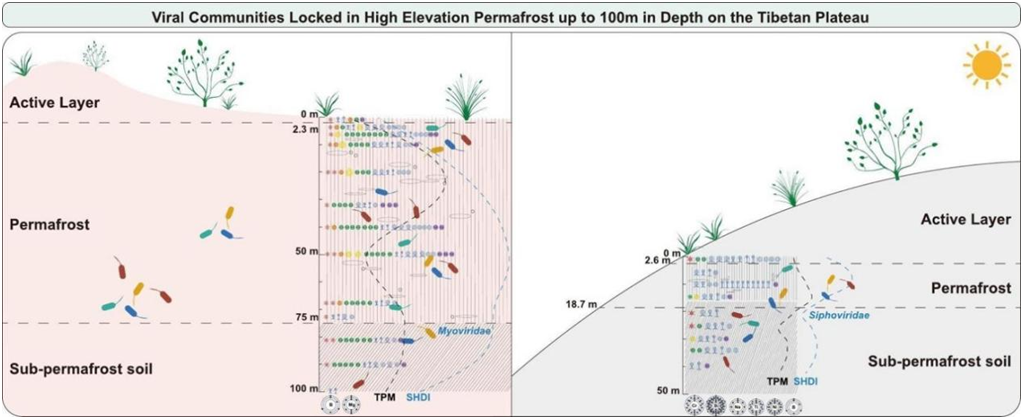Scientists uncovered viral communities locked in high-elevation permafrost up to 100m in depth on the Tibetan Plateau
Date:13-05-2024 | 【Print】 【close】
Permafrost serves as a natural cold reservoir for viral communities. However, little is known about the viromes in deep permafrost soil, as the majority of permafrost studies have been conducted in shallow areas. Climate change-induced degradation of permafrost may potentially impact the prevalence, distribution, and activity of significant viral populations, including vertebrate viruses, plant viruses, and giant viruses.
In this study, the research group led by Prof. Fei DENG and Prof. Shu SHEN from the Wuhan Institute of Virology of the Chinese Academy of Sciences, collaborated with the group led by Prof. Shichang KANG from the Northwest Institute of Eco-Environment and Resources of the Chinese Academy of Sciences, to uncover the viral communities in high-elevation permafrost up to100m in depth on the Tibetan Plateau.
This study investigated two distinct sites in the permafrost regions of the Tibetan Plateau with contrasting ecological backgrounds. Soil samples were collected from shallow to deep depths (up to 100 m) and analyzed based on specific depths and soil layers. The findings revealed not only patterns of the virome but also variations in viral community biomass and diversity with depth. These variations followed a potential trend, with more pronounced changes observed in the deeper soil layers. The observed changes are likely influenced by a complex interplay of environmental factors, including slope, trace elements, pH, and permafrost thickness. Notably, elements such as B, Mg, Cr, Bi, Ti, Na, Ni, and Cu were identified as potentially important elements associated with viral communities, particularly Siphoviridae and Myoviridae in the study area. Their study also revealed the prevalence of tail phages as the dominant population, indicating the “kill the winner” dynamics of ecological communities within Siphoviridae and Myoviridae when competition occurs. Furthermore, giant viral sequences have been discovered and integrated within permafrost. These findings provide valuable insights into the viral community patterns from shallow to 100 m depth in high-elevation permafrost, offering crucial data support for the formulation of strategies for permafrost thaw caused by climate change and anthropogenic activities.
The study has been published in Science of the Total Environment and is entitled “Viral Communities Locked in High Elevation Permafrost up to 100 m in Depth on the Tibetan Plateau”. The first authors are Ph.D. candidate Qian WEN from the Wuhan Institute of Virology and Dr. Xiufeng YIN from the State Key Laboratory of Cryospheric Science, Northwest Institute of Eco-Environment and Resources.
This work is supported by the National Key Research and Development Project, the Key Deployment Projects of the Chinese Academy of Sciences, the Second Tibetan Plateau Scientific Expedition and Research Program, the State Key Laboratory of Cryospheric Science, the Strategic Priority Science and Technology Program of the Chinese Academy of Sciences (Category B), the National Basic Science Data Sharing Service Platform, and the National Science and Technology Major Project.
Paper link: https://doi.org/10.1016/j.scitotenv.2024.172829

Graphical Abstract